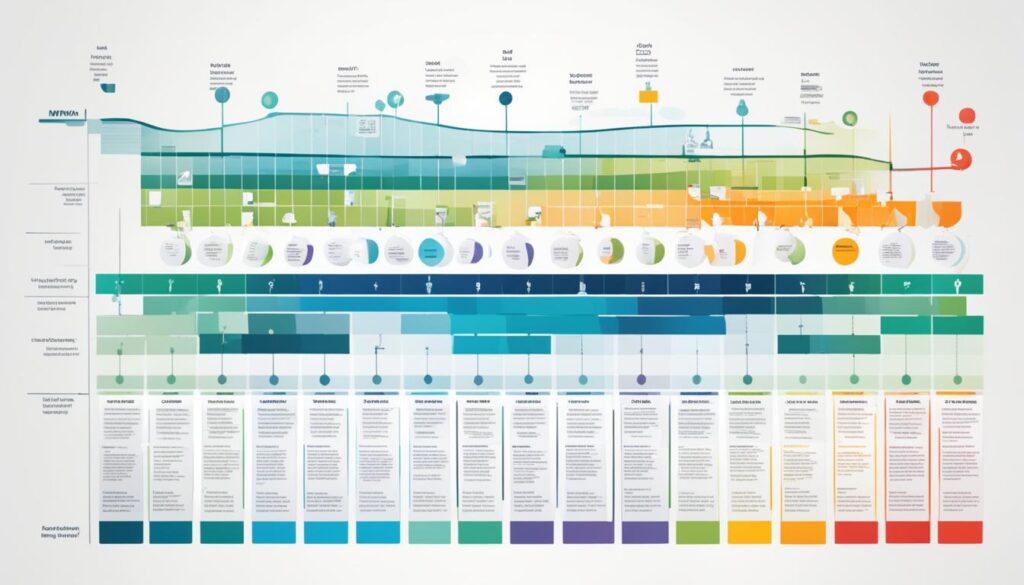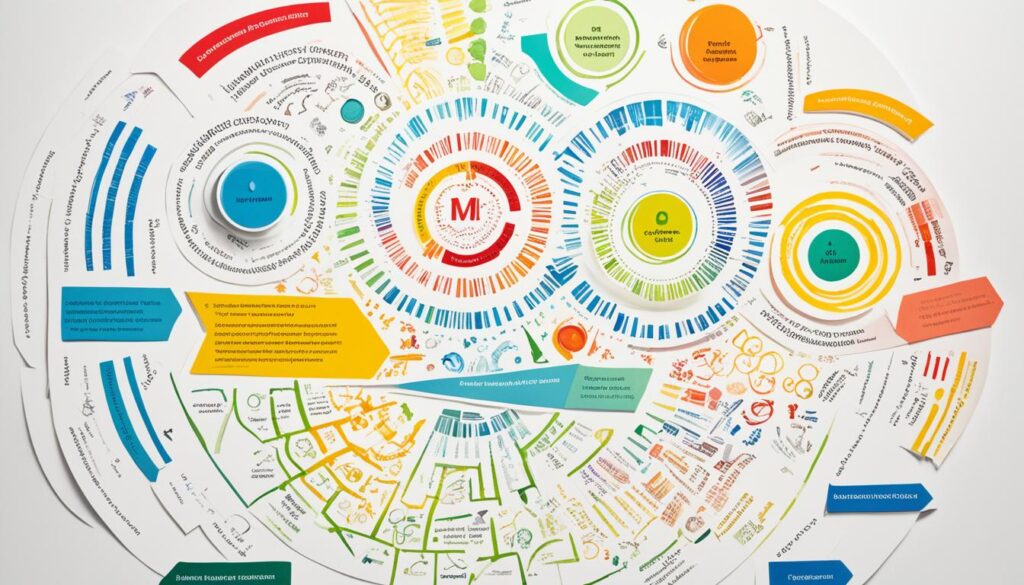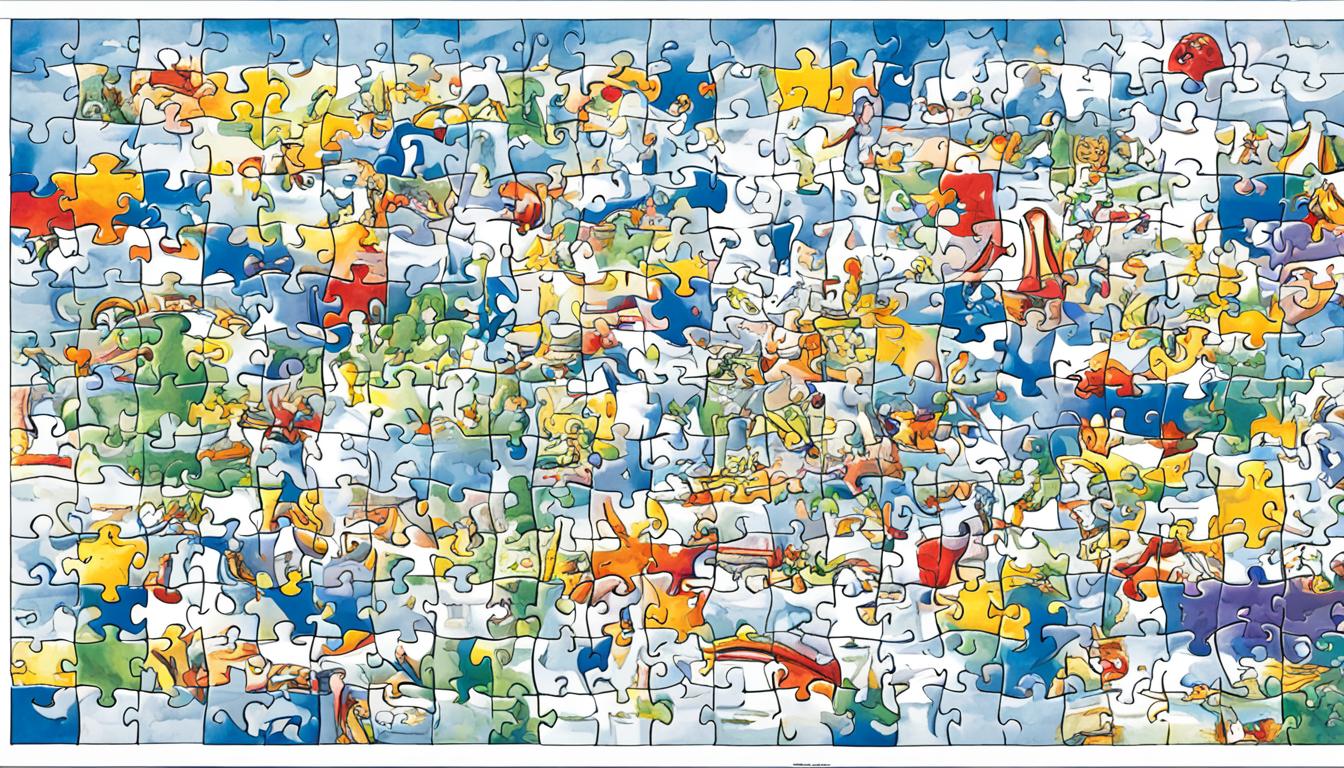Did you know that the Minnesota Multiphasic Personality Inventory (MMPI) is one of the most widely used psychological assessment tools worldwide?
The MMPI is a powerful tool that measures personality traits and provides valuable insights into an individual’s psychological well-being. It is used by trained psychologists and mental health professionals to assess various forms of psychopathology and aid in the diagnosis and treatment of mental health disorders.
Key Takeaways:
- The MMPI is a widely used psychological assessment tool that measures personality traits and psychopathology.
- It is administered by trained psychologists or mental health professionals.
- The MMPI consists of true/false items and utilizes clinical scales and validity scales to interpret the results.
- Criticisms of the MMPI include unfair racial disparities in scoring and some scales lacking scientific validity.
- Interpretation of the MMPI should be done by trained professionals as part of a comprehensive psychological evaluation.
History and Development of the MMPI
The Minnesota Multiphasic Personality Inventory (MMPI) has a rich history rooted in the work of Starke Hathaway and J.C. McKinley at the University of Minnesota in the late 1930s. Their groundbreaking research led to the development of the MMPI, which was first published in 1943. The original purpose of the MMPI was to specifically measure psychopathology.
Unlike other personality tests at the time, the MMPI focused on clinical scales to accurately diagnose patients. Hathaway and McKinley gathered hundreds of true/false questions from individuals both with and without psychological disorders. They selected questions that significantly differed between the two groups, making the test diagnostic in nature.
Over the years, the MMPI underwent revisions and currently exists in two versions – the original MMPI and the MMPI-2. Despite its initial success, the MMPI faced criticisms for factors such as sample bias, limited coverage of mental health issues, and the use of inappropriate terminology.
“The MMPI was an innovative approach to psychological assessment, emphasizing clinical scales to diagnose patients more accurately.” – Dr. James Thompson, Clinical Psychologist
In response to these criticisms, revisions were made, leading to the introduction of the MMPI-2 in 1989. This updated version incorporated a more diverse sample and introduced revised items and sub-scales to address the limitations of the original MMPI. These revisions aimed to improve the test’s reliability and applicability for individuals from various backgrounds.
The development of the MMPI marked a significant milestone in the field of psychological testing, highlighting the importance of clinical scales in accurately diagnosing mental health conditions. The ongoing evolution of the MMPI and its adaptations continue to shape the field of psychological assessment, driving the exploration of new techniques and tools for a more comprehensive and inclusive approach to understanding human psychology.
Types of MMPI Tests
When it comes to the Minnesota Multiphasic Personality Inventory (MMPI), there isn’t a one-size-fits-all approach. The MMPI comes in various versions, each tailored to specific age groups and with unique characteristics. Let’s explore the different versions available:
1. MMPI-2
The MMPI-2 is the standard adult version of the test. It consists of 567 true/false items and typically takes 60 to 90 minutes to complete. Designed to assess personality traits and psychopathology in adults, the MMPI-2 provides valuable insights into various psychological characteristics.
2. MMPI-2-RF
A shorter alternative to the MMPI-2, the MMPI-2-RF contains 338 items and can be completed in around 35 to 50 minutes. Despite its shorter length, the MMPI-2-RF still offers thorough and comprehensive assessment, making it a convenient option for individuals and professionals with time constraints.
3. MMPI-A
Designed specifically for adolescents aged 14 to 18, the MMPI-A consists of 478 items and typically takes approximately an hour to complete. This version is tailored to address the unique psychological characteristics and concerns of adolescents, providing valuable insights into their mental health and well-being.
4. MMPI-A-RF
For even shorter assessment time, there’s the MMPI-A-RF. This version of the test contains 241 items and takes about 25 to 45 minutes to complete. The MMPI-A-RF is specifically designed to assess adolescents and provides a concise yet comprehensive evaluation of their psychological functioning.
5. MMPI-3
Released in 2020, the MMPI-3 is the latest version of the MMPI. With 335 items, it offers a streamlined approach to assessment while still capturing essential psychological traits and characteristics. The MMPI-3 utilizes updated norms, clinical scales, and validity scales to ensure accurate and relevant results.
Each version of the MMPI has been carefully structured and tailored to cater to specific needs and age groups. Whether it’s assessing adults, adolescents, or utilizing the latest advancements in psychological evaluation, there’s an MMPI version suitable for different assessment purposes.
Structure and Interpretation of the MMPI
The Minnesota Multiphasic Personality Inventory (MMPI) is a comprehensive psychological assessment tool that measures various scales to assess an individual’s personality traits and mental health. Its structure includes clinical scales and validity scales, providing valuable insights into specific psychological characteristics and ensuring the accuracy and consistency of the test results.
The MMPI utilizes ten clinical scales to evaluate different aspects of an individual’s psychological functioning:
- Hypochondriasis
- Depression
- Hysteria
- Psychopathic Deviate
- Masculinity-Femininity
- Paranoia
- Psychasthenia
- Schizophrenia
- Hypomania
- Social Introversion
Each scale provides insights into specific areas, such as levels of anxiety, mood disturbances, interpersonal relationships, and cognitive functioning. By analyzing an individual’s responses to the various items, mental health professionals can interpret and understand the individual’s psychological profile.
Additionally, the MMPI includes validity scales that help assess the accuracy and consistency of the test results. The L scale (Lie scale) measures the tendency to provide socially desirable responses or to present oneself in a favorable light. The K scale (Defensiveness Scale) assesses the level of defensiveness and attempts to portray oneself in an unfavorable light. These validity scales are crucial in determining the reliability of the test results and identifying potential response biases.
Interpreting the MMPI should be done by trained professionals who consider the individual’s background, medical history, and other assessment tools. It is important to develop a comprehensive understanding of the individual’s psychological functioning, taking into account both the clinical and validity scales. Through careful analysis and integration of the test results with other diagnostic information, mental health professionals can make informed decisions regarding diagnosis, treatment planning, and therapy.
Below is a visual representation of the clinical scales and validity scales of the MMPI:
| Clinical Scales | Validity Scales |
|---|---|
| Hypochondriasis | Lie (L) Scale |
| Depression | Defensiveness (K) Scale |
| Hysteria | |
| Psychopathic Deviate | |
| Masculinity-Femininity | |
| Paranoia | |
| Psychasthenia | |
| Schizophrenia | |
| Hypomania | |
| Social Introversion |
Note: The validity scales are represented separately from the clinical scales in the table above.

Criticisms and Revisions of the MMPI
While the Minnesota Multiphasic Personality Inventory (MMPI) is a widely used psychological assessment tool, it has not been without criticisms and necessary revisions. Some of the key criticisms revolve around sample bias and cultural bias.
The original sample used during the development of the MMPI consisted primarily of young, rural Caucasian subjects. This limited sample raised concerns about the test’s applicability to diverse populations, questioning its generalizability and accuracy when assessing individuals from different racial and ethnic backgrounds.
Furthermore, criticisms highlighted the presence of sexist and racist questions in the original MMPI. These questions undermined the test’s validity and cultural sensitivity, impairing its ability to accurately assess individuals and provide reliable diagnostic information.
In response to these criticisms, revisions were made to improve the MMPI. One significant revision resulted in the creation of the MMPI-2, introduced in 1989. The MMPI-2 addressed the limitations of the original version by incorporating a more diverse sample, revising and adding new questions, and introducing additional validity scales to enhance the accuracy and validity of the assessments.
Building upon the MMPI-2, further revisions led to the development of the MMPI-2-RF in 2008. The MMPI-2-RF is a briefer version that retains the core strengths of the MMPI-2 while enhancing the metrics and reducing respondent burden.
These revisions have aimed to reduce biases and improve the overall efficacy and reliability of the MMPI assessments. They reflect a commitment to mitigating the criticisms faced by the MMPI and ensuring it continues to be a valuable tool in psychological assessment and treatment.

| Criticisms | Revisions |
|---|---|
| Sample bias | Incorporation of a more diverse sample in MMPI-2 |
| Cultural bias | Revising and adding new questions in MMPI-2 |
| Sexist and racist questions | Introduction of additional validity scales in MMPI-2 |
| Development of the briefer MMPI-2-RF |
Clinical Significance of the MMPI
The Minnesota Multiphasic Personality Inventory (MMPI) plays a vital role in the diagnosis and treatment of mental health disorders. Its clinical significance lies in its ability to provide valuable insights into an individual’s psychological state, aiding mental health professionals in formulating accurate diagnoses and creating appropriate treatment plans.
Through the administration of the MMPI, clinicians can assess and diagnose a range of conditions, including schizophrenia, depression, and anxiety. The test’s comprehensive nature allows for a thorough evaluation of the individual’s symptoms, behaviors, and thought patterns, facilitating a holistic understanding of their mental health.
Furthermore, the MMPI has proven valuable in forensic evaluations, serving as evidence in legal cases such as criminal defense and custody disputes. Its objective and standardized assessment has the potential to provide critical information regarding an individual’s psychological functioning, aiding in legal decision-making processes.
In addition to its diagnostic applications, the MMPI is also utilized in the evaluation of treatment programs, particularly in the field of substance abuse and addiction. By assessing the effectiveness of these programs, the MMPI helps healthcare professionals make informed decisions regarding the appropriate course of treatment for individuals struggling with these issues.
“The MMPI’s comprehensive assessment allows for a thorough evaluation of an individual’s symptoms, behaviors, and thought patterns, facilitating a holistic understanding of their mental health.” Eugene, Personality Test
However, it is important to highlight that the MMPI should not be the sole determinant for making a diagnosis. It is just one component of a comprehensive psychological evaluation that takes into account various factors, including the individual’s background, medical history, and other assessment tools.
| Application | Clinical Significance |
|---|---|
| Diagnosis and Treatment | Provides valuable insights into an individual’s psychological state, aiding in accurate diagnoses and appropriate treatment plans. |
| Forensic Evaluations | Serves as evidence in legal cases, assisting in criminal defense and custody disputes. |
| Treatment Program Evaluation | Evaluates the effectiveness of treatment programs, particularly in the field of substance abuse and addiction. |
Overall, the clinical significance of the MMPI cannot be overstated. It is a valuable tool in the mental health field, providing insights, aiding diagnoses, and contributing to the development of effective treatment strategies for individuals experiencing mental health challenges.

Interpreting the MMPI
Interpreting the MMPI is a task best left to qualified professionals, such as clinical psychologists or psychiatrists, who have received specific training in the use of this assessment tool. It is important to note that the MMPI should be just one component of a comprehensive psychological evaluation and should not be solely relied upon for making a diagnosis. By considering the clinical scales, validity scales, and the individual’s background and context, a trained professional can develop a comprehensive understanding of the individual’s psychological functioning.
A holistic approach to interpretation involves combining the results of the MMPI with other assessment tools and clinical interviews. This allows mental health professionals to gain deeper insights into a patient’s psychological well-being, make informed decisions regarding diagnosis, and formulate appropriate treatment plans and therapeutic interventions. It is through this collaborative process that the MMPI can contribute significantly to psychiatric diagnoses and improve patient outcomes.
Understanding Clinical Scales and Validity Scales
The MMPI includes various clinical scales, such as hypochondriasis, depression, hysteria, psychopathic deviate, masculinity-femininity, paranoia, psychasthenia, schizophrenia, hypomania, and social introversion. These scales provide valuable information about specific psychological characteristics and symptomatology, aiding in the identification and diagnosis of mental health issues.
Additionally, the MMPI incorporates validity scales, such as the L scale (Lie scale) and the K scale (Defensiveness Scale). These scales assess the accuracy and consistency of the test results, helping to identify potential response biases or attempts to present oneself in a more favorable or unfavorable light. By considering both the clinical and validity scales, a more accurate interpretation of the MMPI results can be achieved.
| Clinical Scales | Psychological Characteristics |
|---|---|
| Hypochondriasis | Preoccupation with physical health concerns |
| Depression | Feelings of sadness, hopelessness, and low mood |
| Hysteria | Conversion symptoms and emotional reactivity |
| Psychopathic Deviate | Impulsivity, antisocial behaviors, and egocentricity |
| Masculinity-Femininity | Evaluation of gender role conformity |
| Paranoia | Suspiciousness, distrust, and feelings of persecution |
| Psychasthenia | Anxiety, obsessive-compulsive tendencies, and self-doubt |
| Schizophrenia | Poor reality testing, disorganized thinking, and hallucinations |
| Hypomania | Elevated mood, increased energy, and impulsive behavior |
| Social Introversion | Preference for solitude, social withdrawal, and shyness |
Interpreting the MMPI requires a comprehensive understanding of the individual’s unique psychological makeup. It is crucial for mental health professionals to consider the individual’s background, medical history, and other relevant assessment tools in order to provide accurate and meaningful interpretations. This collaborative approach ensures that the MMPI is used as a valuable tool in psychiatric diagnoses and contributes to the overall well-being of the patient.

Criticisms and Limitations of the MMPI
The MMPI, despite its widespread use and significance in psychological assessment, is not without its criticisms and limitations. These concerns highlight the need for continuous improvements in its design and interpretation. Let’s explore some of the key criticisms surrounding the MMPI:
- Sample Bias: The original sample used in developing the MMPI primarily consisted of young Caucasian subjects, which has raised concerns about its applicability to diverse populations. The test may not accurately capture the experiences and psychopathology of individuals from different cultural backgrounds, leading to potential diagnostic inaccuracies.
- Cultural Bias: In line with sample bias, the MMPI has been criticized for its potential cultural bias. Some argue that certain items on the test may not be culturally relevant, and that the underlying constructs and norms may not be universally applicable. This raises questions about the test’s validity when assessing individuals from different cultural contexts.
- Overlap Across Clinical Scales: Critics have pointed out that there is some overlap across the clinical scales of the MMPI. This can make it challenging for clinicians to accurately differentiate between certain psychopathological conditions and may impact the precision of diagnostic interpretations.
- Length and Complexity: Another criticism of the MMPI is its considerable length and complexity. The test consists of a substantial number of items, which can be time-consuming for both the assessor and the assessed. This may lead to fatigue and affect the accuracy of responses, potentially impacting the overall validity of the test results.
Ongoing research and revisions in the development of the MMPI, such as the introduction of the MMPI-2, have attempted to address some of these limitations and criticisms. By incorporating a more diverse sample and revising certain items, the MMPI-2 aimed to enhance the cultural applicability and accuracy of the assessment. Nevertheless, it is crucial for clinicians to approach the MMPI with a critical eye, considering its limitations and the potential biases that may arise from its use.
We recognize the importance of addressing criticisms and limitations surrounding the MMPI. Let’s explore the clinical significance of the MMPI in the next section.
Conclusion
In conclusion, the Minnesota Multiphasic Personality Inventory (MMPI) is a highly valued psychological assessment tool that has been extensively used in clinical settings for many years. It offers valuable insights into personality traits and various forms of psychopathology, aiding mental health professionals in accurate diagnosis and treatment planning. Over time, the MMPI has undergone revisions, resulting in versions like the MMPI-2 and MMPI-2-RF, which have addressed some of the limitations and biases of the original test.
The MMPI’s significance extends beyond clinical settings, as it plays a role in forensic evaluations and evaluating treatment program effectiveness. However, it is crucial to interpret the MMPI results with caution, as they should be part of a comprehensive psychological evaluation conducted by trained professionals. Considering the individual’s background, context, and other assessment tools alongside the MMPI results ensures a holistic understanding of their psychological functioning.
While the MMPI has faced criticisms and limitations, such as sample and cultural bias, ongoing research and development in the field of psychological assessment aim to improve its accuracy and relevance. The MMPI remains an essential tool in mental health, providing valuable information that can guide diagnosis, treatment, and therapy.
FAQ
What does the Minnesota Multiphasic Personality Inventory (MMPI) measure?
The MMPI measures personality traits and different forms of psychopathology.
What is the purpose of the MMPI?
The purpose of the MMPI is to assess and diagnose mental health or clinical issues in individuals.
Who administers the MMPI?
The MMPI is administered by trained psychologists or mental health professionals.
How many versions of the MMPI are there?
There are several versions of the MMPI, including the original MMPI, MMPI-2, MMPI-2-RF, MMPI-A, MMPI-A-RF, and MMPI-3.
How long does it take to complete the MMPI?
The time to complete the MMPI depends on the version, ranging from 25 to 90 minutes.
How is the MMPI interpreted?
The MMPI is interpreted by trained professionals who consider the individual’s background, medical history, and other assessment tools to develop a comprehensive understanding of their psychological functioning.
What are the criticisms of the MMPI?
The MMPI has faced criticisms for sample bias, cultural bias, and limitations in scale overlap.
What is the clinical significance of the MMPI?
The MMPI holds clinical significance in diagnosing and treating mental health disorders, evaluating treatment programs, and providing forensic evidence in legal cases.
Is the MMPI the sole determinant for making a diagnosis?
No, the MMPI is just one component of a comprehensive psychological evaluation and should not be the sole basis for a diagnosis.
Augustus is the visionary leader and Editor-in-Chief of Personality-Test.net. With an unwavering commitment to quality and authenticity, he oversees all content, ensuring it enlightens and empowers our audience. Augustus believes deeply in the transformative power of self-awareness and is dedicated to making Personality-Test.net a beacon for those on a journey to understand themselves better.










